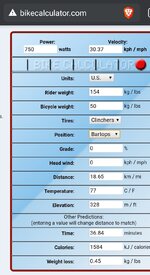IMO the three class system is a unmitigated disaster, marketing applied to law instead of using some more sensible art as the basis for law, like oh, I dunno,
physics. The difference between a class 1 and a 2 is basically who can ride the thing, so more or less codified discrimination against the disabled, that's just
wonderful. The difference between 1&2 and 3 is a speed sensor limitation, which can and is being defeated by users on the 1's and 2's because it's a artificial distinction without a practical difference, which is not even available as a speed or access mode to disabled users at all. The ADA should sue the pants off these ebike companies, the AG's that adopted this legislation. The bike was a marvelous invention, and the ebike is a sea changing incremental improvement on that model that physically levels the playing field for *all* bicycle users young and old, able bodied or not. If the problem is
speed, then make road style bikes, velomobiles, or basically anything that helps efficiency and saves energy illegal - or, perhaps more sensibly, put up speed limit signs and enforcement. If the problem is
power or
weight such as may be the case on soft trails, then a power or weight restriction makes *sense*. I seem to recall seeing weight restrictions on bridges for this reason. Logical. Fire the marketing director in charge of law writing and lobbying

My personal feeling is that for an all age, all user, all access
bicycle the power limit doesn't need to be so high. I think we can make do with a 2nd tier cyclist pedaling for us or along side us at 250-350w. The way the CPSC did that trick with the 20 mph power limit is basically low-key genius though, because it accounts for power to weight variations that would occur for bikes intended for users of heavier tricycles that may have balance issues, etc. I have throttle bikes, cadence sensor bikes, and now just got a torque sensor assist bike. I don't want or need a throttle and I can say that I vastly *prefer* the torque assist, it is the best freaking thing since sliced bread! But also, my legs work. If they didn't, and I was rendered a second class cyclist because of some lobby group that was high on their own supply, I'd be pissed.
Ken, I have low hopes that the law can or will be made sensible in any way at this stage with the big money behind creating a new bicycle
class system of have's and have-not's, but good effort!

